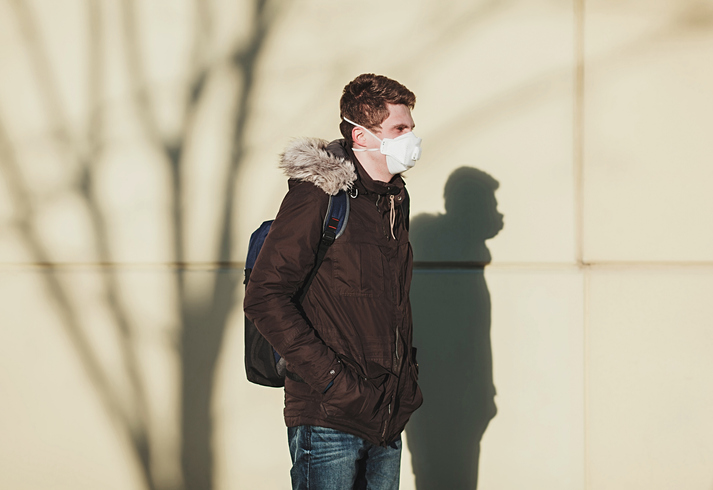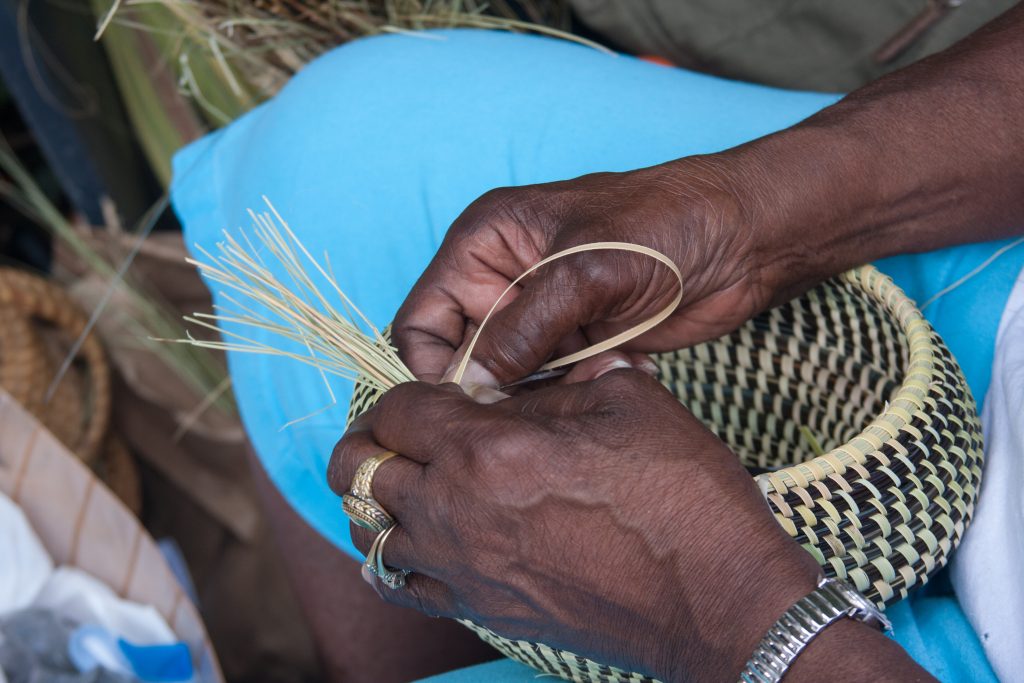Welcome to CMI.
Our in-class classes never stopped. Things are the same. We waited and waited, then the virus never came.
Walking around here, living life, nothing is different from before. I live in what usually seems like an alternate reality anyway—a piece of linguini in the middle of the Pacific that, in many places, you can walk across in less than a minute.
The Republic of the Marshall Islands is a country of 58,000 composed of 29 coral atolls. Majuro is the capital and another atoll, Kwajelein, is home to a U.S. military base.
The College of the Marshall Islands is the only college based in the country. The University of the South Pacific has a presence here, but is a Fijian university operating in nine countries across the Pacific. CMI is a small school, with about a thousand students a semester.
I started teaching English here in January 2020 and I remember one of the things that entertained me those first couple of weeks was: what if this coronavirus becomes a pandemic and I wind up stuck on this island in the middle of nowhere while everyone else is forced to quarantine? Now wouldn’t that be crazy?
After midterms, as everything was shutting down around the world, the president of the college held a faculty meeting in the old library. She said we would be moving all the classes online the following week. Judging by the reaction of many veteran instructors she may as well have just said that on Monday students would need to be able to fly.
A person on Kwajalein Atoll was a coronavirus PUI (Person Under Investigation). The college was closing its face-to-face classes. Since they now saw the question as when not if, this potential case just made the matter even more pressing.
IT scrambled to figure out a way to get the students internet access. Like other countries with low internet penetration (much of the U.S. included), going online was not immediately feasible for much of the population. Too large a majority simply does not have internet access at home. Exact numbers are hard to come by but going by information from the National Telecommunications Authority and the colleges own IT department, most homes lack internet. I also asked an internet installation worker what he thought the numbers were. He said far below half the people on the atoll have it.
My last job was at a community college in Lee County Alabama, which faces a similar issue. Majuro is not that different from the rural communities we served. There are crushed remains of salvaged-wood-and-wire chicken coops and rust-stained, overgrown playgrounds. There are buildings made of tin, found objects and tarps.
A person who might think that their state is not like that in parts as well has not gone off their rarefied path. Those used to college-town living see this as impoverished, foreign. Those who have spent time in the rest of the country, in towns abandoned by industry or razed by fentanyl and methamphetamine, will not see that difference. The life-expectancy here, 65, may seem low but is higher than many places in the U.S.
In 2019 the FCC estimated 21% of people do not have internet access in the U.S. For Black and Hispanic people that percentage is higher than White and Asian.
Unlike other low-income, low-internet-penetration areas and countries, however, COVID did not come here.
The Monday after the meeting we were supposed to start entirely online. I prepared and trained the students for two full classes in computer labs. Monday came, however, and we did not make the switch. We were all back in school. The order had been changed. I heard from some coworkers that it was going to be an impossible transition for the students.
I learned that week that the Person Under Investigation tested negative for coronavirus. As the person had been just PUI, not a real case, and it seemed that was not the main reason we were going online, there was confusion.
I kept my classes online. News came that the country was going on lockdown. Nobody was allowed in, but the U.S. government was asking everyone to head back to the States. I was supposed to leave around week 11 so I kept with the original plan and didn’t go back to face-to-face.
Still getting my footing in a first semester in which I had already come prepared to be a newborn teacher for a few months, going online shook everything up again, back to zero. Other instructors also opted to stay online. Attendance and submissions were low. Being a new teacher I was not sure how much of it was from the move to online. I also learned that already there was usually a big drop after spring break.
A few days before my flight my anxiety was ballooning. The students were having a lot of trouble doing the online work. They were not coming to online forums, responding to emails, or submitting assignments. Instead of getting on the flight back I told students we would resume meeting in class the next week, and stayed.
How many of the students were capable of using Google Docs, let alone able to get everything done on the online learning platform Moodle? There had been only face-to-face-based classes here, though some components online and some Moodle use among instructors. Attendance was already exceedingly low, and the graduation rate, while improving in bounds by the Herculean efforts of staff and faculty, had gotten better but still had a long way to go.
A few other instructors stayed online. They also had some classes in which small fractions of students were submitting their work and attending online forums.
The confusion that the college created by going online and then back to the classroom created further confusion for students who were already facing numerous challenges to maintaining student engagement. Even in its absence COVID-19 has made traditionally low attendance worse.
There is always a great deal of discussion about why attendance, participation and graduation rates are low. Answers of course vary, but I have never seen a faculty more dedicated to student participation, nor one so committed to the students. When my classes started having the low attendance I had been hearing about I sent emails to students to see how they were and to let them know what they were doing. I hung around the campus to look for students to get them to do their work. One student I even saw across the street on the weekend and chased down while she tried to avoid eye-contact.
Doing chores for the family often takes precedence over school. Family activities, and gatherings on other islands are given much more importance than tests. Some say students also do not pay tuition so there is not a feeling of wasted money. I have also talked to a couple students who, relatedly, say that they just come here for something to do—hang out, use wi-fi, eat, see friends. Graduate or not, it’s just a thing to do after high school. However, there are mostly incredibly talented and dedicated students here.
Because of the Pell Grants school is free. And it is really free—textbooks and meals even. In the second half of the semester they get a refund for the grant money they haven’t used. Like with its healthcare system here, this sovereign nation has universal access to higher education, paid for by the U.S. government even though these services are not also enjoyed by its own citizens.
All the while the rest of the world went through a monstrous change. Cities shut down, millions went out of work, people were dying by the thousands. On Facebook I saw acquaintances posting from hospitals, getting treated for COVID-19.
The struggle outside of the Marshall Islands for some of us hovered between a bad dream, tv news about tragedy in a foreign land you keep a step removed from, and people just offshore on a sinking ship you can do nothing about. Video calls with people back home made it a bit more real, but a reality that disappeared after hanging up once an immediate thing came up.
Here at the college we plugged along as usual. The country itself went on lockdown and did not allow people entry. People could go out, and the only people who were allowed in were some Marshallese high school students who had been studying in The Federated States of Micronesia. They were quarantined in a house on a satellite campus of the college.
I heard many young people here making a joke out of it all. “Oh, do you have COVID? Haha.” A drunk college-age guy approached me to talk when I was on an early-morning walk, laughing, about whether I had coronavirus.
And so we kept going to classes, studying and teaching. I made an effort to wash my hands all the time, to learn to stop touching my face, and to avoid contact with people. But time went by and I slipped back to normalcy.
It is the school so many of us have dreamed of teaching at. We have so many opportunities to make a difference in students’ lives. It is genuinely a great school, better than any other I have worked at. As faculty we take on extra responsibilities and have more autonomy. Likewise the small community college does the same for the country. It built the country’s quarantine center on its campus. We are stockpiling dry goods and planting crops to help if food becomes scarce and the students—a highly vulnerable population—have little to eat.
According to the IMF the country’s per capita GDP is less than $4000. The poor parts of town look like one would expect a country with this kind of poverty to look. There is an unending battle with trash and street animals. Children of all ages run around and play games in public spaces during school hours.
However, there are also ocean views everywhere you go. You can walk on miles of reefs past screensaver-style little tropical islands, and you can snorkel shipwrecks right in town. Whether I am doing any good here or not, it is a great feeling to at least imagine I help people up the economic ladder. The privilege of doing so against this backdrop is unreal.
Some students have bought into learning online, some improved their scores, some didn’t. Sending emails and tracking them down has gotten some better grades, as has hanging around school ten hours a day and on holidays in case a student wants help. I would not have gone so far out of my way for the privileged kids of millionaires and billionaires, students that I have had at other schools. I am not proud of that. In the future when the coronavirus comes and the whole school goes online other students might commit to distance learning in the same way.
Education issues from the coronavirus mirror those we face in serving communities which need support. The lessons learned to help non-traditional and disadvantaged students here are not unique: flexibility for submissions, extra time for late assignments they could not submit due to learning a new platform or software, constant availability and prioritizing approachability, normalizing computer and cultural literacy.
Home internet access during the pandemic has gone from an advantage to a prerequisite for successful and healthy students. The need to go online puts a blistering spotlight on the challenges of leveling the playing field for students that schools and countries were already facing. Quarantine and coronavirus notwithstanding, this is a problem that needs to be dealt with for all schools to serve and adapt effectively. As much as anywhere else coronavirus has given us a critical moment to either decisively address gaps in service of the have-nots or risk losing those students for good.
Geoff Goodman is an English, ESL and EFL teacher who has taught in Seoul, Rhode Island, Alabama and the Republic of the Marshall Islands. Contact him at [email protected].












